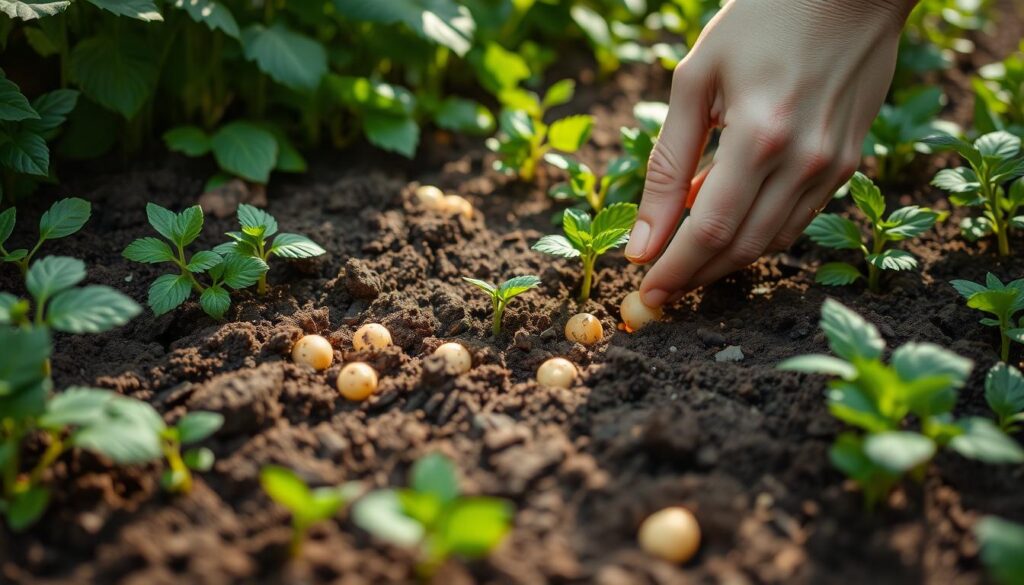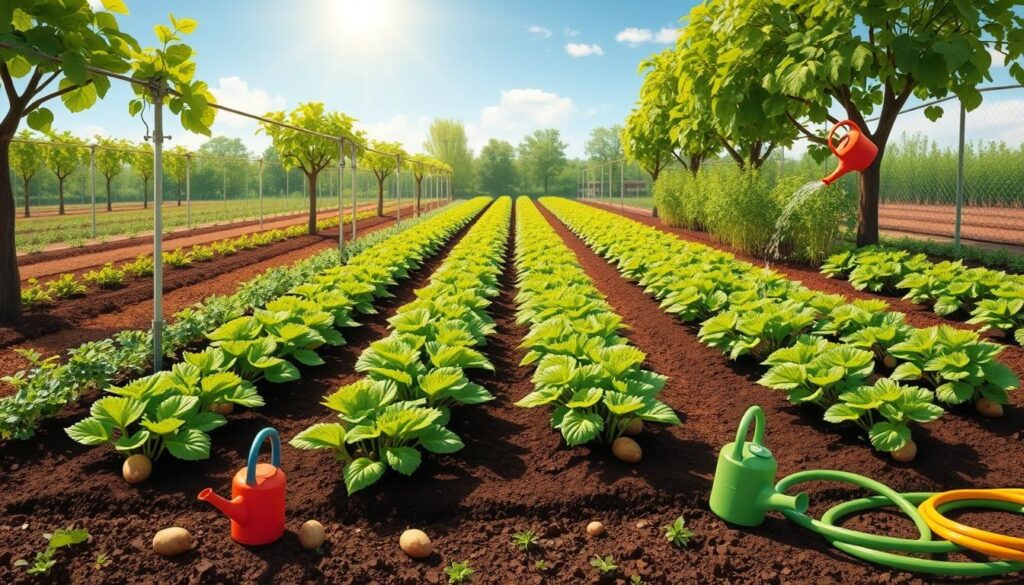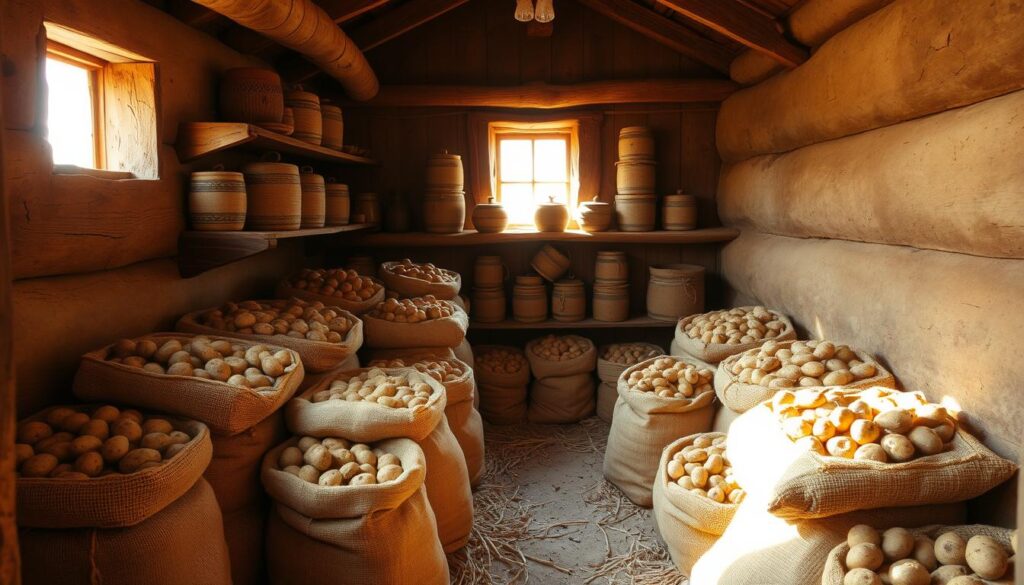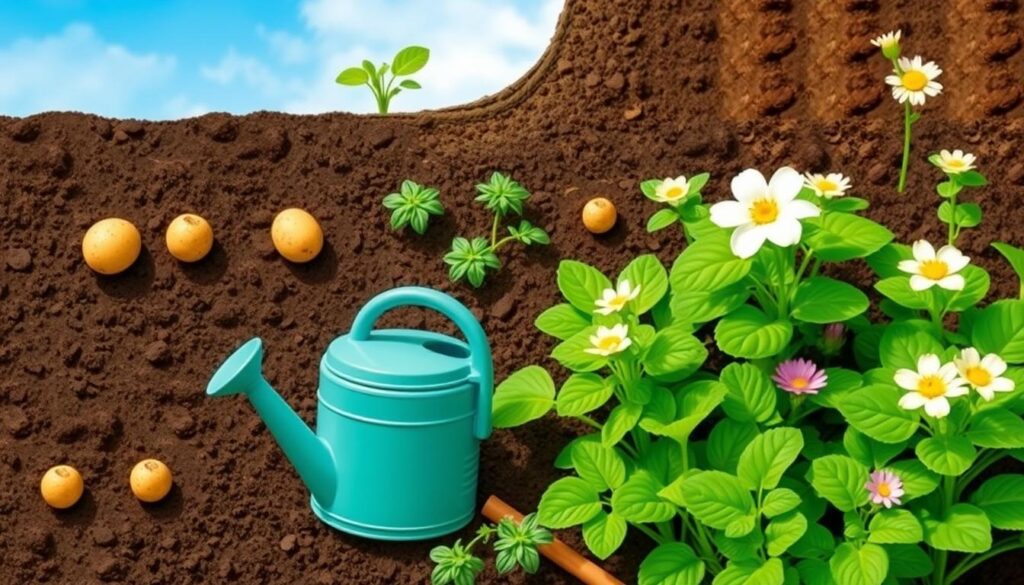Learning to grow potatoes is fun and rewarding. With the right techniques, you can enjoy a lot of delicious potatoes. Growing potatoes at home needs some knowledge and skills, but we’ve got you covered. This article will cover the basics of potato gardening, including understanding different types of potatoes and providing the right conditions for optimal growth.
Whether you’re a beginner or an experienced gardener, this guide will help you grow delicious potatoes. We’ll talk about how to grow potatoes, including preparing the soil, choosing the right variety, and providing the right conditions for optimal growth. With these proven methods, you can enjoy a successful harvest of growing potatoes at home.
Introduction to Potato Gardening
Our goal is to give you a complete guide on how to grow potatoes, so you can enjoy a bountiful harvest. We’ll cover everything from understanding different types of potatoes to providing the right conditions for optimal growth.
Key Takeaways
- Learn how to grow potatoes with proven methods
- Understand the basics of potato gardening, including soil preparation and variety selection
- Discover the right conditions for optimal growth, including sunlight and watering
- Get tips on how to grow delicious potatoes at home
- Enjoy a successful harvest with our complete guide on growing potatoes
- Learn about the different types of potatoes and how to choose the right one for your garden
Understanding Potato Varieties for Your Garden
Choosing the right potato variety is key for a great harvest. With many options, picking the right ones for your garden can be tough. To enhance your backyard gardening experience, learn about the different potato types and their traits.
For backyard gardening, consider early, mid, and late season potatoes. Each has its own benefits and drawbacks. Knowing these differences helps you choose the best potatoes for your garden.
Early Season Potatoes
Early season potatoes grow fast, ready in 70-100 days. They’re perfect for small gardens or containers. They’re great for beginners or those who want a quick harvest.
Mid-Season Varieties
Mid-season potatoes take 100-120 days to mature. They offer a good balance of yield and disease resistance. They’re a favorite among gardeners for a dependable harvest.
Late Season Options
Late season potatoes take over 120 days to mature. They yield more and store better. They’re ideal for those who want to keep their potatoes longer.
By picking the right potato variety for your garden, you can enjoy a rich harvest. This makes the most of your potato planting tips and best potatoes for backyard gardening journey.
Essential Tools and Materials for Potato Growing
To start growing potatoes at home, you need the right tools and materials. This includes seed potatoes, a garden bed or container, soil, fertilizer, and a watering system. When picking seed potatoes, think about the variety and quality you want. This will affect your harvest. You can buy seed potatoes at a gardening store or online.
Some key steps to grow potatoes successfully include preparing the soil, planting the seed potatoes, and providing adequate care. You’ll also need a tool for hilling, like a hoe or a garden fork. Here are some essential items to get you started:
- Seed potatoes
- Garden bed or container
- Soil and fertilizer
- Watering system
- Hilling tool (hoe or garden fork)
By following these steps and having the necessary tools, you’ll be well on your way to a bountiful harvest. Growing potatoes at home can be a rewarding experience. With the right materials, you can enjoy a successful crop.
Selecting the Perfect Growing Location
To grow potatoes well, pick a spot that’s just right. Think about sunlight, space, and drainage. These steps help your potatoes grow strong and healthy.
Sunlight Requirements
Potatoes love full sun to partial shade. Make sure they get at least 6 hours of direct sunlight daily. This boosts their growth and health.
Space Considerations
Potatoes need room to spread out. Your garden bed or container should be 12 inches deep and 2-3 feet wide. This lets their roots grow and the plants thrive.
Drainage Factors
Drainage is key for potatoes. They don’t like standing water. Choose a spot with soil that drains well and avoid wet areas.
Keep these tips in mind to create the best spot for your potatoes. With the right location and techniques, you’ll have a great harvest.
How to Grow Potatoes: Step-by-Step Guide
To grow potatoes, you need to follow a few key steps. First, prepare the soil right for planting potatoes. This means adding fertilizer and organic matter to make it rich in nutrients.
Next, plant the seed potatoes 2-4 inches deep, with the eyes up. Make sure to cover them with soil and hill them as they grow. This way, only a few inches of leaves will be exposed. Here are some extra tips:
- Keep the soil moist but not too wet
- Support the plants as they grow
- Watch for pests or diseases
By using these techniques and knowing what your soil needs, you can grow lots of tasty potatoes at home.
Stay tuned for the next part. We’ll talk about how to prepare your soil for the best growth.
| Potato Growing Stage | Soil Requirements |
|---|---|
| Planting | Fertile soil with a pH between 4.5 and 7.0 |
| Growth | Consistent moisture and adequate nutrients |
| Harvest | Soil that is easy to dig and free of debris |
Preparing Your Soil for Optimal Growth
When growing potatoes, the soil is key for a good harvest. Before planting, you need to prepare the soil well. This means checking the pH, adding nutrients, and improving the structure.
A potato harvesting guide stresses the need for good soil. The best pH for potatoes is between 4.5 and 7.0. To get this, add compost or well-rotted manure to adjust the pH and add nutrients.
Soil pH Requirements
The ideal pH for potatoes is flexible but important. You can test your soil pH with a DIY kit or send a sample to a lab.
Nutrient Enrichment
Adding nutrients is vital for healthy potato growth. Use a balanced fertilizer like 10-10-10. You can also enrich the soil naturally through crop rotation and composting.
Soil Structure Improvement
Improving soil structure is also key for potatoes. Add perlite or vermiculite to improve drainage and aeration. This helps potatoes grow better.
By following these tips, you’ll be on your way to a great potato harvest. Don’t forget to check a potato harvesting guide for advice on when and how to harvest.
| Soil pH | Nutrient Enrichment | Soil Structure Improvement |
|---|---|---|
| 4.5-7.0 | Compost, manure, fertilizer | Perlite, vermiculite |
Planting Techniques and Timing
Timing is key when growing potatoes at home. Planting at the right time can greatly impact your harvest. In most areas, the best time to plant is early spring, when the soil is ready.
This early start helps your potatoes grow well before summer’s heat. Follow these tips for planting: place seed potatoes 2-4 inches deep, with eyes up. Cover them with soil. You can also plant in the fall, 10 weeks before the first frost.

- Soil temperature: Potatoes prefer cooler soil, so aim for a temperature of around 40-50°F (4-10°C).
- Moisture: Keep the soil consistently moist, but not waterlogged, to promote healthy growth.
- Support: Provide support for your potato plants as they grow, using a trellis or cage to keep them upright and promote better yields.
By following these simple tips, you can enjoy a rich harvest of homegrown potatoes. Growing potatoes at home can be both fun and rewarding.
Container and Raised Bed Growing Methods
Container and raised bed growing methods are perfect for small gardens or urban areas. They let you control the soil and drainage, key for growing potatoes. With the right steps, you can have a big harvest, even in a small space.
Start by picking a container that’s at least 12 inches deep with drainage holes. Use a well-draining potting mix and plant the seed potatoes 2-4 inches deep. For raised beds, build a frame with wood or composite materials and fill it with soil and compost. Growing bags are also great for potatoes.
Benefits of these methods include:
- Improved drainage and soil quality
- Increased control over temperature and moisture
- Reduced risk of pests and diseases
- Higher yields and better flavor
By using these methods and following the right steps, you can enjoy a delicious harvest of homegrown potatoes.
With practice and patience, you can grow potatoes at home. Enjoy the many benefits of homegrown produce.
| Method | Benefits | Challenges |
|---|---|---|
| Container Growing | Improved drainage, increased control | Limited space, possible waterlogging |
| Raised Bed Growing | Better soil quality, reduced pest risk | Higher initial cost, soil erosion risk |
| Growing Bags | Easy to use, high yields | Limited space, overheating risk |
Watering and Irrigation Strategies
Watering and irrigation are key for growing potatoes. Soil needs to stay moist but not too wet. This prevents diseases. Use a soaker hose or drip irrigation to water the roots directly.
Soil needs the right moisture for potatoes. Mulch helps keep the soil moist and stops weeds. This keeps the soil healthy for your potatoes.

- Water your potatoes in the morning for better absorption
- Stay away from overhead watering to avoid fungal diseases
- Check the soil moisture often to keep it just right
These strategies can help you grow better potatoes. Always think about the soil needs for a great harvest.
Managing Pests and Diseases
When you grow potatoes at home, it’s key to watch out for pests and diseases. Common pests like aphids, wireworms, and potato beetles can harm your plants. Diseases, such as fungal and bacterial infections, can spread fast.
To keep pests away, try organic methods like neem oil, insecticidal soap, or row covers. These are kind to the environment. You can also rotate your crops and keep your area clean to stop diseases. For instance, planting marigolds or nasturtiums alongside potatoes can help keep pests away.
Common Pests
- Aphids: small, soft-bodied insects that feed on plant sap
- Wireworms: larvae of click beetles that feed on plant roots
- Potato beetles: insects that feed on plant leaves and stems
Disease Prevention
Stopping diseases is vital when growing potatoes at home. Use fungicides and keep things clean to stop disease spread. Choosing resistant potato varieties can also help. By following these steps and your potato harvesting guide, you can have a healthy crop.
Organic Control Methods
Organic ways to control pests and diseases are good for the planet. Neem oil, insecticidal soap, and row covers are effective. You can also use physical barriers, like fine mesh, to keep pests out. By using these methods and your potato harvesting guide, you can grow tasty potatoes at home.
Hilling and Maintenance Practices
To grow potatoes well, following the right steps is key. One important part is hilling and maintenance. As plants grow, mound soil around them, leaving a bit of leaves showing. This method helps in making more tubers and stops them from turning green.
Some important potato growing techniques include:
- Keeping the soil consistently moist
- Providing support for the plants as they grow
- Removing any weeds or debris that may be competing with the potatoes for water and nutrients
By following these steps and using the right techniques, you can grow a healthy potato crop. 
Remember, the secret to growing great potatoes is to give them the right care. With the right techniques and a bit of practice, you can grow potatoes successfully and enjoy a big harvest.
| Potato Growing Stage | Maintenance Practice |
|---|---|
| Planting | Water thoroughly and provide support |
| Growth | Hill the soil and remove weeds |
| Maturity | Check for greening and harvest at the right time |
Harvesting Your Potato Crop
As you near the end of your potato harvesting guide, timing and technique are key. The soil you plant potatoes in greatly affects your harvest quality. When the plant tops turn yellow and die, it’s time to harvest.
Using a garden fork to loosen the soil around the plants is a must. This step prevents damage to the tubers, which can rot and spoil. By using the right techniques and considering soil quality, you can have a great harvest.
Timing Your Harvest
The harvest time varies based on potato variety. Most are ready when the plant tops turn yellow and die. Regularly check the tubers to catch the best harvest time.
Proper Digging Techniques
To protect the tubers, gently loosen the soil with a garden fork. Then, dig up the tubers carefully to avoid skin damage. This keeps them fresh longer.
Post-Harvest Handling
After harvesting, handle the potatoes carefully to avoid skin damage. Store them in a cool, dark place to keep them fresh. By following these steps and considering soil quality, you can enjoy a successful harvest.
Storage Solutions for Long-Term Freshness
After harvesting your potatoes, it’s key to store them right to keep them fresh. For those growing potatoes at home, store them in a cool, dark spot. A basement or root cellar works well.
Here are some tips for storing potatoes:
- Keep them away from light to stop chlorophyll production and greening
- Use containers or bags that let air in to store the potatoes
- Don’t wash the potatoes before storing to avoid moisture and rot
Having a good storage plan is important to enjoy your potatoes all year. By following these tips and using the right storage, you’ll enjoy your potatoes longer.

Proper storage is vital for keeping your potatoes quality. With the right methods and storage, you’ll enjoy your potato-growing journey and the delicious results.
Conclusion: Growing Success with Your Potato Garden
As you finish our guide on how to grow potatoes, feel proud of what you’ve learned. You now have the skills to grow your own delicious potatoes. With the right potato planting tips, you’re ready for a great harvest.
Success in growing potatoes means choosing the right varieties and preparing the soil well. Also, make sure you give them the right growing conditions. Don’t be shy to try new things in your garden. The fun of gardening is in the discovery.
If you face any problems, ask for help. The gardening community is full of people eager to share their knowledge. Together, we can help your potato garden grow strong and give you plenty of this tasty crop.
Happy gardening, and may your potato-growing adventures be fruitful and fulfilling!
FAQ
What are the best potato varieties for backyard gardening?
For backyard gardening, ‘Russet’, ‘Yukon Gold’, and ‘Red Thumb’ are great choices. Early season potatoes grow fast. Mid and late season varieties offer different yields and storage qualities.
What tools and materials do I need to grow potatoes at home?
You’ll need seed potatoes, a garden bed or container, and soil. Don’t forget fertilizer and a watering system. A tool for hilling, like a hoe or garden fork, is also necessary.
What are the soil requirements for planting potatoes?
Potatoes like well-draining, loose soil with a pH of 4.5 to 7.0. Add organic matter and fertilizer to enrich the soil for growth.
When is the best time to plant potatoes?
Plant potatoes in early spring when the soil is workable. You can also plant in the fall, 10 weeks before the first frost.
Can I grow potatoes in containers or raised beds?
Yes, growing potatoes in containers or raised beds is great for small spaces. Choose a deep container with drainage holes or build a raised bed with good soil and compost.
How do I water and irrigate my potato plants?
Keep the soil moist for potato growth. Use a soaker hose or drip irrigation to water the roots. Avoid overhead watering to prevent disease. Mulch to retain moisture and control weeds.
How do I manage pests and diseases in my potato garden?
Watch out for aphids, wireworms, and potato beetles. Use neem oil or insecticidal soap for control. Prevent disease with crop rotation, sanitation, and fungicides if needed.
When should I harvest my potato crop?
Harvest potatoes when the plant tops start to yellow and die. Use a garden fork to gently dig up the tubers. Be careful not to damage them.
How do I store my harvested potatoes for long-term freshness?
Store potatoes in a cool, dark place with good air flow. Use breathable containers or bags. Avoid washing before storage to prevent rot.
Share this post: on Twitter on Facebook

